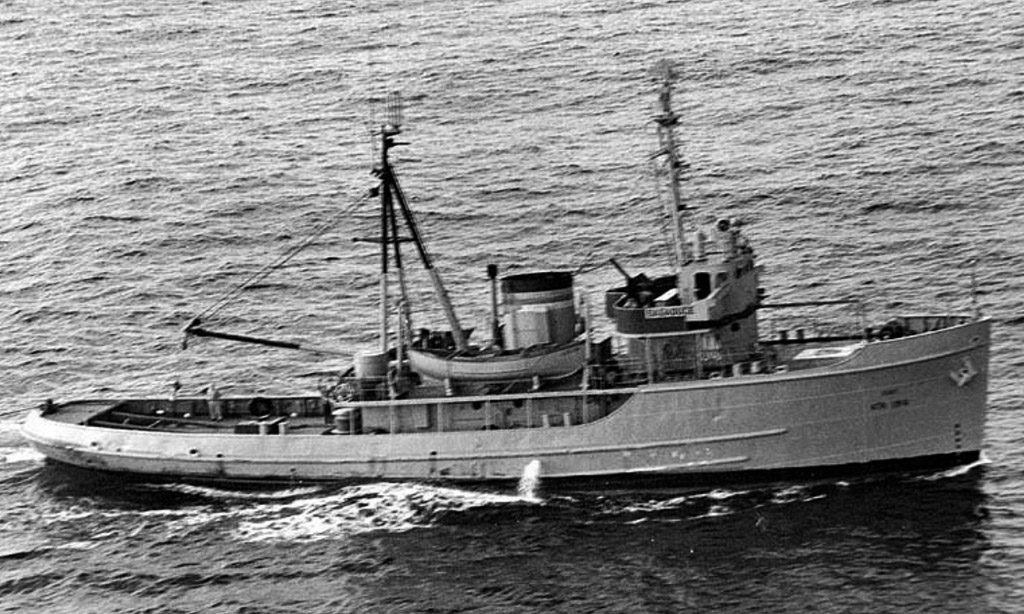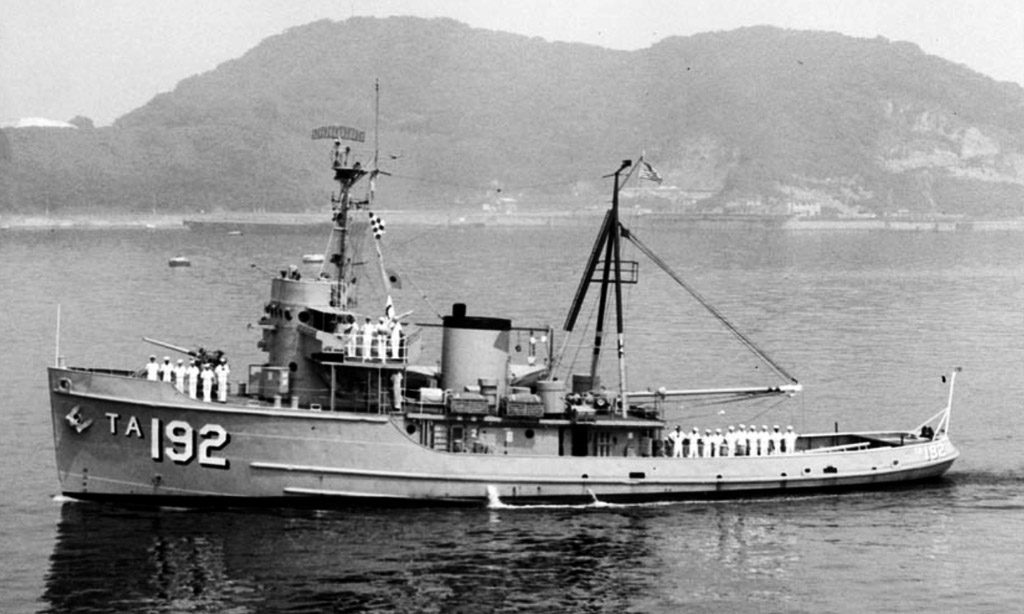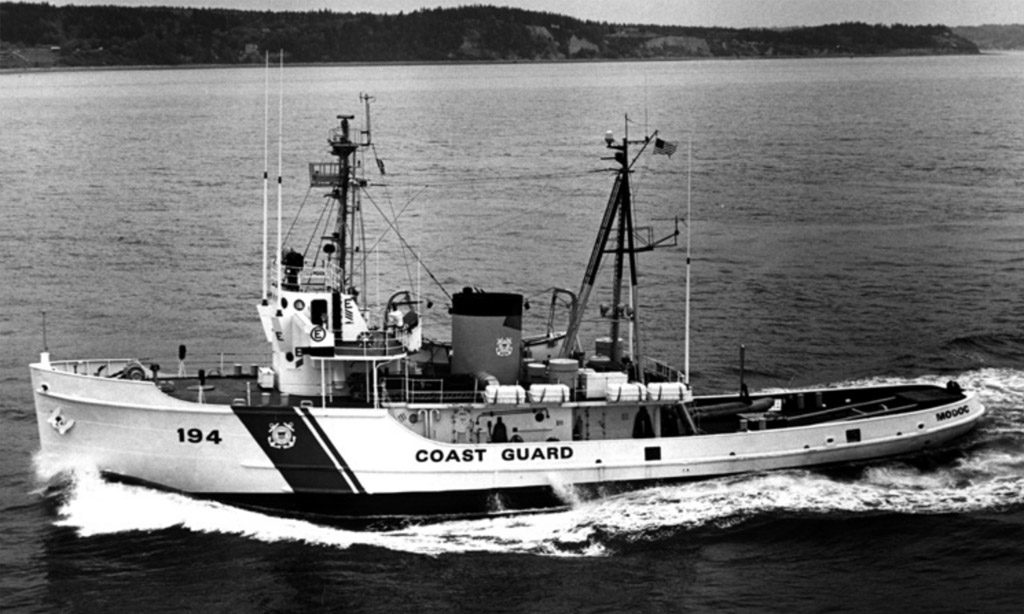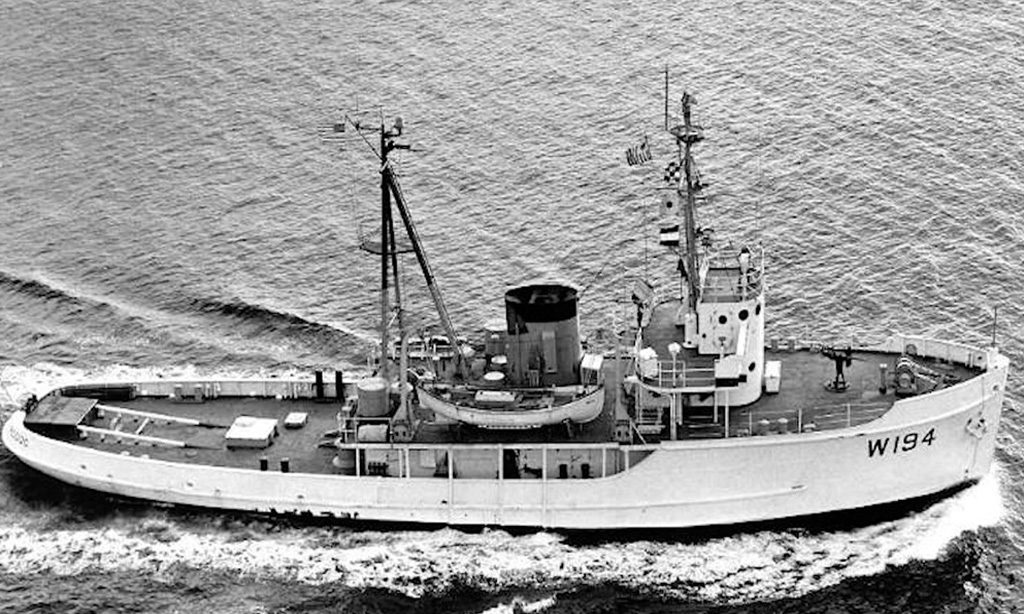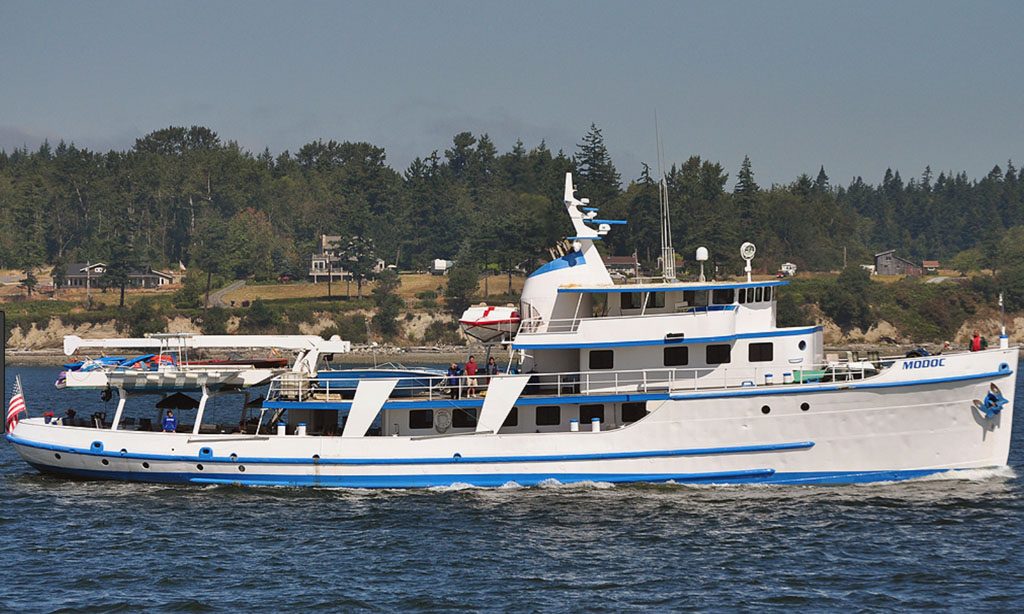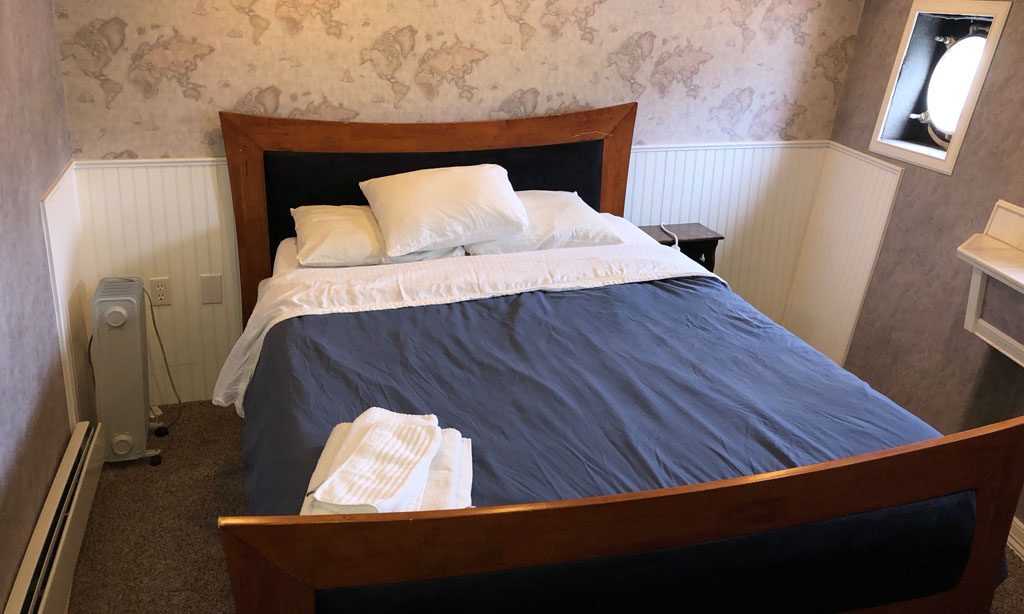Modoc
In 2019 Earthrace purchased the former US Navy / US Coastguard vessel the Modoc, and this remarkable 45m (150ft) vessel is now our base of operations. She is a fully equipped blue-water patrol vessel that can spend up to 30 days at sea un-assisted. She has an extensive workshop, training room, 10-ton crane, FLIR thermal imaging, and a while range of tactical hardware. It supports a
military UAV and a
K9 tracking unit. We can deploy nearly anywhere in the world to offer a wide range of services to National Park Authorities. These can include
training,
fishery patrols, delivery of personnel and equipment to remote Atolls, oceanic scientific research, and support base for Island Pest Eradication programs. We can run SAR Operations, and surveillance missions over both land and water.
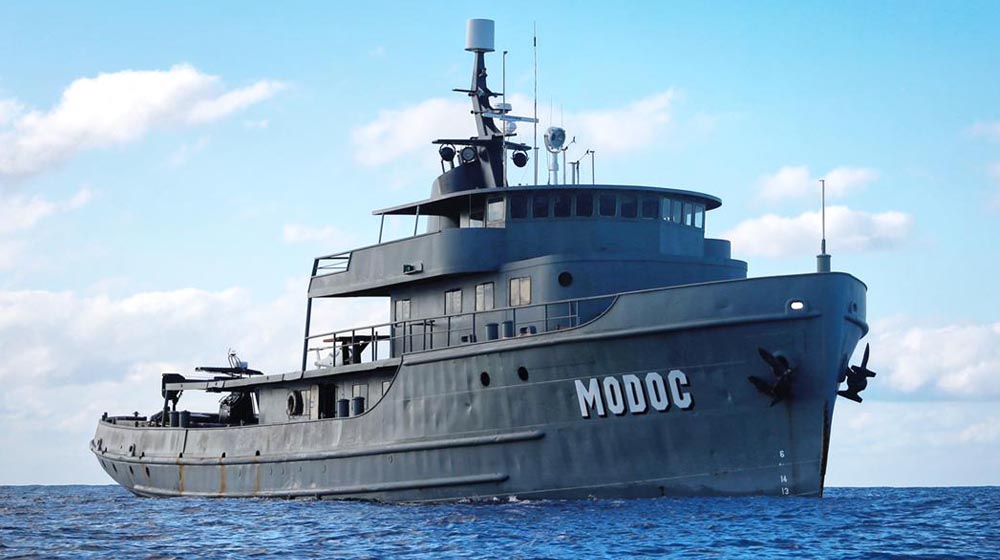
Former US Navy Ship the Modoc is our Base of Operations
M/Y Modoc
• Former US Navy and US Coastguard Cutter
• 45m in Length, 10m Beam
• Crew Complement: 25
• Training Capacity: 12 persons
• Range: 8,000nm
• 10m x 10m helipad
• Training / Briefing Room
• Raymarine / FLIR Marine electronics
• Fixed mount and hand held FLIR Thermal Imaging systems
• 10 ton crane
In 2019 we completed a substantial refit of the vessel in Ensenada (Mexico). Major work included relocating our crane to the lower deck, and converting the upper deck into a 10m x 10m flight deck. Much of the ship has now been completely rewired. Also the plumbing, which in some cases was marginal at best, has been redone. Both engines have undergone considerable repairs, and one of them has been completely rebuilt. We've made space on the lower deck for the
RIB, zodiac and barge.
In late 2019 we ran a combined fishery patrol and scientific research project in partnership with CONANP (Mexico Govt. National Park Authority) to the remote "Revillagigedo MPA". Included were stops at San Benedito, Socorro and Clarion Islands to drop off construction and other supplies. On-board Scientists took samples on the Islands and at various locations around the marine reserve. In 2020 we voyaged to Costa Rica where we are now based for 12 months providing support services in a variety of land and marine National Parks (
more).
The boat itself, despite being old, and despite having some areas of rust, is in remarkable condition. Her hull is corten steel which is partly why she has aged so well. Also the fact that she was built by US Military to very high standards. They don't build boats like this anymore, largely because of the expense. Below are some technical details, followed by her long history, that started in World War II.
Below are a series of images of the ship. The big table you see was built from an awesome 317 year old "Douglas Fir" log was harvested in the 1920s, and used to float a houseboat near Portland (Oregon, USA). The log eventually lost buoyancy and was abandoned in the Willamette River. The log was subsequently recovered by a generous volunteer that donated it to us on the Modoc. Most of the wood panels, benches, tables, and skirting on the ship are from this log. Being a conservation ship, we are also careful to make use of what we have. As we rebuild various areas of the ship, we are forever coming across cool and interesting copper, brass and steel hardware that we reuse in other ways. A few of these are in the images. The aluminium grid you see surrounded by green is the landing grid for the UAV. In heavy seas when landing our S-100, we deploy a harpoon that locks into this grid on landing. This is an amazing old ship, and in many ways we feel like we are custodians of her, and we are very lucky to get this opportunity.
[slider]
[/slider]
[/vc_column_inner]
[/vc_column][/vc_row]
History - USS ATA-194 (US Navy Operations 1944 - 1958)
The Motor Vessel MODOC was built for the United States Navy in 1944 at Levingston Shipyard in Orange, Texas. Her history from there has been quite remarkable, and she has served all manner of missions throughout the Pacific. Modoc was initially classed as a "Auxiliary Ocean Tug, and given the official ensign USS ATA-194. She arrived at Buckner Bay, Okinawa, on 14 October 1945, just before Typhoon Louise struck the anchorage on the 15 October 1945 and caused severe damage among the assembled ships. As a consequence, she spent the next several months aiding stricken warships and support craft damaged in that storm. These salvage operations included retracting two Landing Craft Infantry (LCI) from the beach and an Auxiliary Mine Sweeper (YMS) from a reef. Assigned to the Philippine Sea Frontier, the tug remained in the Far East into the following year of 1946. In the spring of 1946, she supported preparations for Operation Crossroads, a two-detonation atmospheric nuclear test held in summer, 1946 at Bikini Atoll in the Marshall Islands. She returned to the US west coast in late May 1946 and moored at Seattle, Washington, on 15 June 1946.
Reassigned to the 17th Naval District, ATA-194 sailed for duty in Alaskan waters where she was based for the next 6 years. She was named "Bagaduce" on 15 July 1948 (Crew in fact gave her the nickname "douchebag"). Upon arrival in Seattle on 2 July 1953, she was transferred to the 13th Naval District and ordered to prepare for assignment to the Military Sea Transportation Service (MSTS).
"Bagaduce" was decommissioned on 17 July 1953 and transferred to MSTS on 31 August 1953. Assigned to the northern Pacific, she returned to the Kodiak area for another five years of towing duty. The tug was transferred to the Maritime Administration, for lay-up in its National Defense Reserve Fleet (NDRF) at Olympia, Washington, on 25 August 1958. Her name was struck from the Naval Vessel Register that same day and she was subsequently transferred to the US Coast Guard.
WATA/WMEC-194 (US Coastguard Operations 1959 - 1979)
The tug was transferred to the US Coast Guard and was commissioned under the command of LT Clarence J. Pare, Jr., as the Auxiliary Tug USCGC Modoc (WATA-194) on 20 April 1959, named in honor of the Modoc Indians. She then reported to her home port of Coos Bay, Oregon, where she replaced the aging 125-foot cutter USCGC Bonham (WSC-129). Bonham's crew had cross-decked to Modoc and a rumor from the time was that her commissioning had been ordered so quickly that there had not been sufficient time to paint over her entire Navy gray hull and only the shore-side of Modoc was painted white. From 1959 to 1969 she was stationed at Coos Bay, Oregon where she was used for coastal and off-shore search and rescue, oceanography, and law enforcement duties, primarily fisheries enforcement. Her normal area of operations extended from the California–Oregon border to Canada and she was also occasionally called upon to patrol the Gulf of Alaska. When not underway, Modoc was on continual alert and was capable of getting underway within two hours to proceed to a vessel in distress.
A unit history written by an anonymous crewman sometime in the mid-1970s noted:"Designed and built from the keel up along the lines of a classic European oceangoing tug, the MODOC will literally tow anything afloat. She is fully equipped to carry out major coastal and long-range search and rescue operations, one of her two major mission areas. MODOC's other prime mission is law enforcement. This cutter, along with other west coast cutters, patrols the waters off Oregon, Washington, and California, locating and identifying foreign fishing vessels. In addition, the operations and catch of these vessels are monitored and the vessels frequently boarded. Foreign vessels found in violation of US fisheries laws within 12 miles [22 km] would be brought into port and prosecuted in federal court."
Her boom and heavy towing gear was removed in August 1963. Also during that month her crew assisted in a special guard detail at Tongue Point Coast Guard Base, Oregon, during a visit by President John F. Kennedy at the dedication of the first Job Corps center on the west coast. In January 1965 she assisted the Canadian tug La Force, for which the owners of La Force, the Vancouver Tug Boat Company, presented the cutter with a silver tea service. On 20 September 1967 she escorted the disabled Danish M/V Marieskou following a collision with the Chitose Maru four miles north of Cape Flattery. Modoc was reclassified as a Medium Endurance Cutter, WMEC-194, in 1968. She and her sister Comanche (WMEC-202) were the smallest cutters designated as WMEC. On 17 March 1968 she assisted USS Chowanoc (ATF-100) recover her tow of DE-373 25 miles west of Coos Bay.
During 28 February 1968 to 1 March 1968 Modoc, USCGC Ivy (WLB-329), MV Kure Maru and MV Transoneida assisted following collision between the Japanese M/V Suwaharu and the Liberian M/V Mandoil II off Oregon. While Ivy was waiting out a storm at anchor in Willapa Bay, Washington; Ivy was called to assist the Japanese M/V Suwaharu Maru carrying a cargo of logs and the Liberian M/V Mandoil II carrying a cargo of naptha which had collided 340 miles from the Columbia River Bar off the Oregon coast. Due to heavy seas Ivy was underway to the scene for nearly 24 hours. In heavy seas, darkness and a snow storm Ivy rescued 68 crewmen from the Japanese vessel, which had jettisoned logs in an effort to stay afloat. Floating logs destroyed one of Ivy's lifeboats, however no men were lost. The Liberian tanker of naphtha exploded and burned; the entire crew perished. Ivy was relieved by Modoc and transported the Japanese crew to Astoria, Oregon.
On 1 August 1968 she rescued the lone survivor from the F/V Rodoma. From 1970 until 1976 Modoc was stationed at Coos Bay, Oregon. A patrol summary dated 17 October 1970 gives some insight into her routine patrols:
"The U.S. Coast Guard Cutter MODOC (WMEC-194) with its crew of 5 officers and 34 enlisted personnel returned to port today after completing Law Enforcement Patrol duties off the coast of Oregon and Washington. The ship was underway for 120 hours and traveled 955 miles ... Thirty-six different Soviet vessels were detected operating between 14 and 20 miles off shore from Cape Arago to Grays Harbor ... No violations of the contiguous fishing zone or territorial waters were detected."
On 3 June 1972 an off-duty Modoc crewman, SA James Carignan, of Olympia, Washington, drowned while attempting to save a 12-year-old girl who had been swept away from a beach by the surf. He was posthumously awarded the Coast Guard Medal. In January 1974 Modoc braved 100-knot (190 km/h) winds to assist the stricken tug Sea Racer and her tow, the former Liberty ship Arlington. In November 1974 she retrieved the 40-foot high special environmental data buoy EBO-2 from the Cobb Seamount. On 15 May 1975 she seized the Polish 278-foot fish factory trawler Kalmar 10 miles off Monterey, California, for fishing inside the 12-mile limit and escorted her to San Francisco. A news release about the incident noted:
"The Polish fishing vessel KALMAR, seized by the Coast Guard 10 miles off the Monterey coast early this morning was cited for fishing inside the 12-mile limit. Homeported in Swinouj'scie, Poland, the vessel carries a crew of approximately 70 men. The KALMAR fished off the West Coast during the 1974 foreign fishing season. It was first observed fishing off California in 1975 off Half Moon Bay on January 14 by a Coast Guard Air Station aircraft patrol from San Francisco. In March 1975 she was observed conducting fishing operations in the vicinity of Coos Bay, Oregon. During April and May of this year Coast Guard patrols observed the KALMAR fishing off Point Reyes, Half Moon Bay and Santa Cruz."
In August 1975 Modoc safely towed the disabled East German stern-trawling factory-ship Rudolph Leonhard to Coos Bay. In November of that year, during a severe gale, she attempted to locate the hulk of the Korean fishing vessel Kwang Myong No. 96 that had been abandoned by her crew after a fire. Modoc was unable to locate the hulk and turned back after heavy seas caused 45-degree rolls that led to injuries among some of the crew and caused structural damage.
Modoc transferred back to Coos Bay in 1977 where she remained for the remainder of her Coast Guard career. In August 1978 she towed the disabled 48-foot Canadian sailboat Naganek to Astoria, Oregon after her operator reported that his engine had failed and that his wife had been killed attempting to enter the engine room. The Coast Guard later ruled her death to be an accident. Modoc departed on 28 October 1978 to undergo a renovation and refurbishment period at the Lake Union drydocks near Seattle. While returning to her home port on 18 December 1978, Modoc narrowly avoided a collision with the loaded 810-foot tanker Arco Sag River at the mouth of the Strait of Juan de Fuca.
After 18 years of U.S. Navy service and 20 years of U.S. Coast Guard service, Modoc was decommissioned on 31 May 1979 at Coast Guard Base Seattle. Modoc was placed on "Inactive, Out of Commission, In Reserve" status. Her final commanding officer was LCDR C. G. Boyer, USCG. Her crew cross-decked to her replacement, the 180-foot tender Citrus (WLB-300). Modoc was later sold.
MV Modoc (Alaska Tourism, 1990 - 2017)
In 1990, Washington Boatbuilder Peter Benneson purchased the Modoc, renaming her "MV Modoc Pearl". Through a substantial refit lasting the better part of a decade, the vessel is completely transformed into what at the time, was the latest in luxury accommodation - A Master Stateroom complete with hot tub, 4 other luxury staterooms with en-suites, a Hot Tub on the back deck, and an array of jetskis, skiffs, kayaks, and other toys. In 2004 through until 2016, Benneson ran tourist voyages in Alaska over the summer, and a luxury Bed and Breakfast in Gig Harbor, WA in the winter. Rumors surfaced of the vessel being chartered yearly by a group of pilots that would fly prostitutes, cocaine and alcohol up to Alaska and party on the vessel, although these rumors were denied by Benneson. In 2016 the vessel was purchased by a couple of Washington boat Captains who used her for parties and accommodation in Bremerton Marina.


